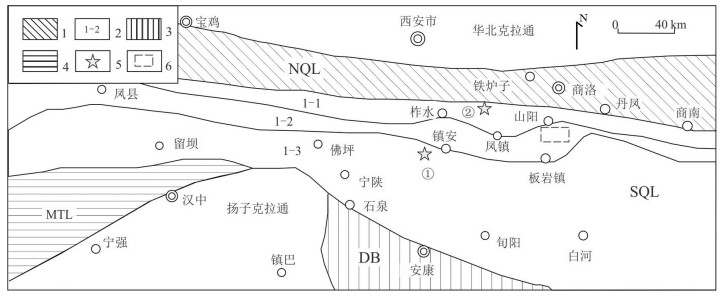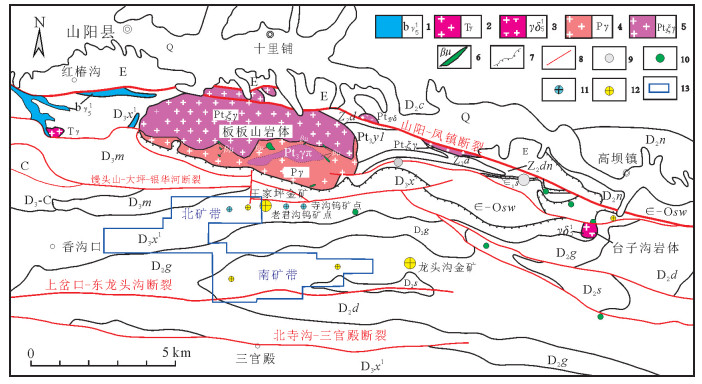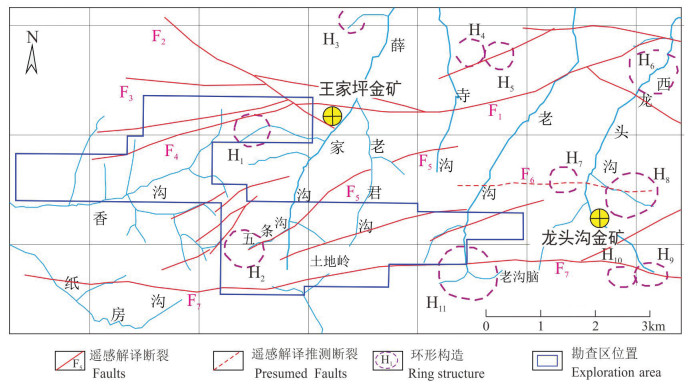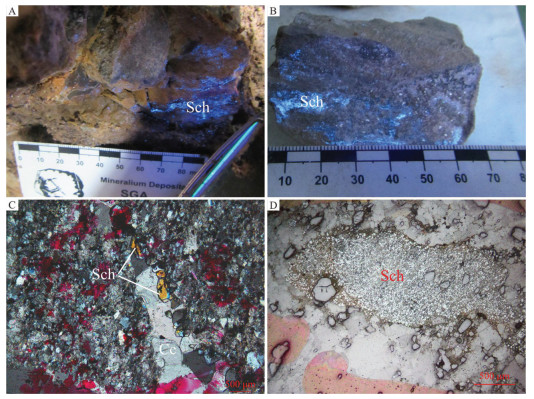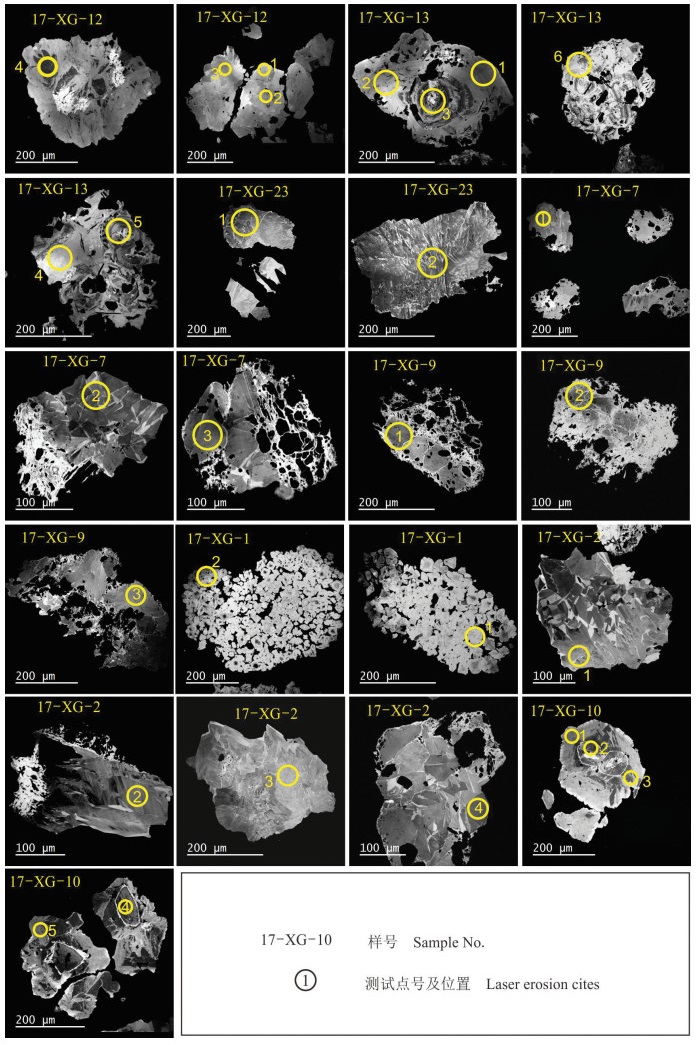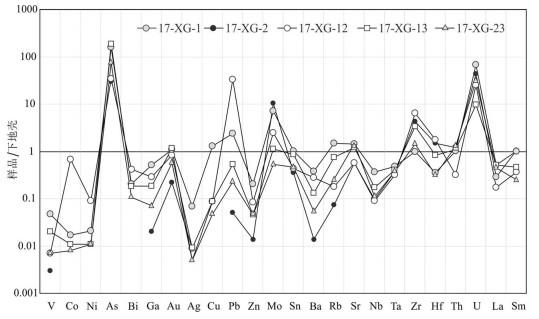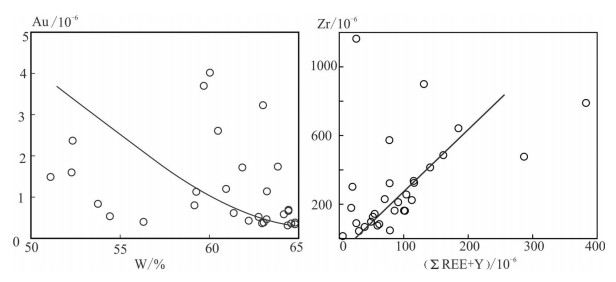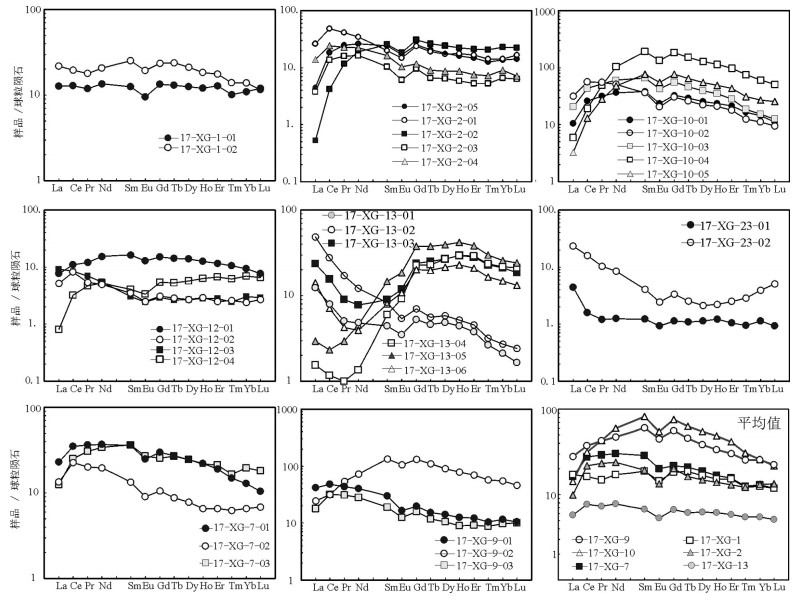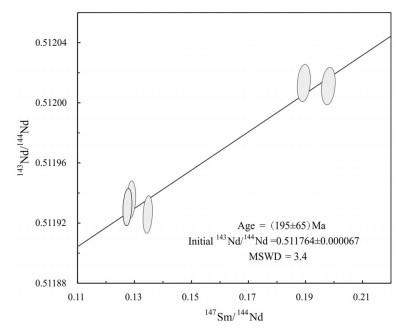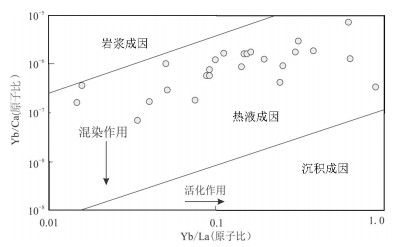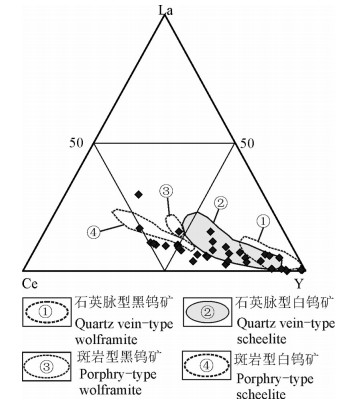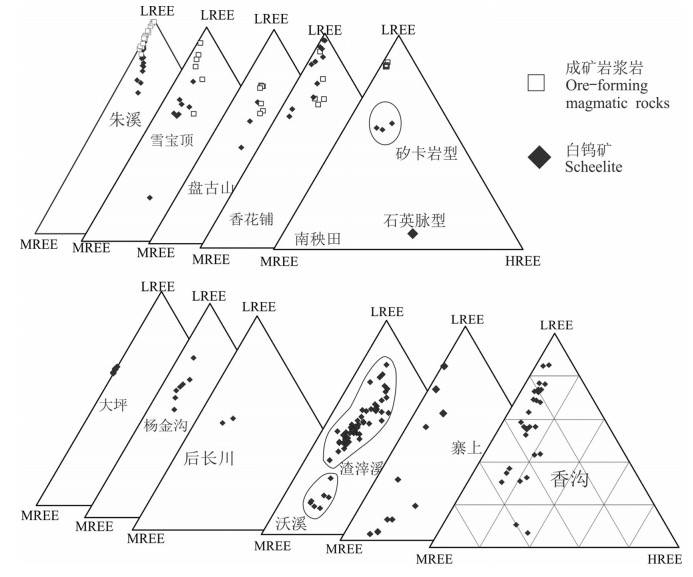Scheelite geochemical signature and calcite Sm-Nd dating of the Xianggou Au-W deposit in south Qinling orogen, central China: Constraints on the ore-forming process
-
摘要:
陕西省山阳县香沟钨矿是近年来南秦岭地质勘查新发现的钨矿化地段之一。本文开展了白钨矿电子探针、LA-ICP-Ms和共生方解石的Sm-Nd同位素测年,研究结果显示:香沟白钨矿成矿过程至少可划分为两个阶段,由早阶段韵律环带白钨矿至晚阶段集合体状白钨矿,白钨矿经历了多次迁移;白钨矿具有高F、含微量Au元素的特征,稀土总量较高(ΣREE+Y含量介于5.44×10-6~382.67×10-6,平均为95.48×10-6),其稀土配分型式为无MREE富集的平坦型,与Ghaderi等人划分的白钨矿Ⅱ型稀土配分型式总体类似,负铕异常,利用白钨矿La-Ce-Y三角图解,结合地质事实,判断香沟钨矿属于石英脉型钨矿;结合共生方解石Sm-Nd同位素年龄195 Ma,认为南秦岭香沟钨矿是印支末期深部隐伏岩浆-热液活动的结果。
Abstract:The Xianggou scheelite deposit, discovered in the Wangjiaping-Longtougou-Xiajiadian gold metallgenic belt in recent years, is another new geology survey progress in south Qinling related to W mineralization. The composition of scheelite was analyzed by LA-ICP-MS, together with Sm-Nd isotope dating of symbiotic calcite, to clarify the origin of Xianggou scheelite. The results show that scheelite exists in three generations, from the early rhythmic zonal scheelite to the late aggregate one, indicating that the scheelite undergone multiple migrations. The scheelites have high F content with low Au content. The total amount of rare earths is high, ranging from 5.44×10-6 to 382.67×10-6, with an average of 95.48×10-6. The REE pattern is flat without MREE enrichment, with negative Eu anomaly, similar to the type Ⅱ REE type classified by Ghaderi et al. (1999). All these data support that the W mineralization in the Xianggou area might be related to W-bearing quartz vein with genetic links to magmatic hydrothermal activities. The Sm-Nd isotope dating result of the symbiotic calcite (195 Ma) indicates that the deposit was formed in the late Indosinian.
-
1. 引言
四川盆地东部长兴组礁滩相储层为重要的天然气勘探目的层,且主要分布于开江-梁平海槽的东西两侧[1-5]。碳酸盐沉积后作用与储层储集性能的关系十分密切,碳酸盐岩孔隙的形成、增大、减少甚至消失的整个演化历史,除受沉积作用和沉积环境的控制外,更受碳酸盐沉积物的各种沉积后作用的控制[6-8]。环开江-梁平海槽礁滩相储层在埋藏成岩过程中,各种成岩作用对礁滩体孔隙结构影响较大,次生孔隙在长兴组碳酸盐岩中广泛发育,为研究区最主要的储集空间之一,其发育程度直接决定着礁滩体的储集能力。因此,成岩作用研究对于认识川东北环开江-梁平海槽长兴组礁滩相储层的形成演化、控制因素具有很强的借鉴作用。鉴于此,笔者通过前期钻井和最新钻井的岩石宏微观研究和常规物性分析结合前人研究成果,对环开江-梁平海槽长兴组礁滩相储层的特征进行阐述,并进一步探讨储层发育的主要成岩作用,最终为储层的形成机制及有利储层的分布预测提供理论依据。
2. 区域地质背景
开江-梁平海槽位于四川盆地东部,属于扬子板块北缘的一部分(图 1)。晚二叠世龙潭(吴家坪)期在华蓥山以西,由沼泽潮坪相过渡到河流相与康滇古陆相邻,以东为局限海台地相[9]。长兴期大规模海侵,使局限海台地相移至华蓥山以西,沼泽潮坪相和河流相依次向古陆退却,以东为开阔海台地相。受盆地多期构造运动(特别是峨眉地裂运动)影响,开江-梁平海槽发育于中二叠世晚期区域拉张应力背景,形成和发展于晚二叠世长兴期勉略洋扩张和NW向基底断裂活动的断陷期,消亡于早三叠世飞仙关期的勉略洋闭合阶段[10, 11]。基底正断活动通过对古地理的影响来实现对生物礁的控制,生物礁受张性正断层上升盘“断隆”控制,分布于基底断裂古上升盘断阶处,如环开江-梁平海槽台地边缘礁滩体[12]。
长兴末期世界范围内海平面均发生了一次一定幅度的下降事件[13-21],盆地内多个野外露头的长兴组顶部均发现了相关的沉积-成岩响应,如川东涪陵地区二龙口剖面长兴组顶部风化壳岩溶不整合的发现[21],蜀南地区长兴组顶部岩溶不整合的发现[17],形成的岩溶组构(溶沟、溶缝、溶洞及岩溶角砾)表明长兴组在长兴末期受到了表生岩溶水的明显改造。
3. 储层特征
3.1 岩性特征
环开江-梁平海槽长兴组岩性较多,而能成为储层的岩性主要为“花斑状”生屑云岩和生物礁云岩。
(1)“花斑状”生屑云岩为滩相沉积,主要由棘屑滩、藻屑滩和少量砂屑组成,以棘屑滩为主,多与生物礁复合构成礁滩复合体。受早成岩期岩溶[22, 23]影响强烈,表现出典型的“花斑状”特征(图 2-a),其灰白色部分为基岩,灰黑色部分为遭受烃类侵位的岩溶系统[24]。该类岩石由于沉积时具有较高的原始孔隙度,同时有利于后期流体改造,因而具有较好的储集性;宏观上形成大量针孔和溶蚀孔洞,且岩溶系统中溶蚀孔洞明显较基岩发育,为区内最主要的储集岩。
![]() 图 2 环开江-梁平海槽长兴组储集岩及储集空间照片a-龙岗82井4220.11~4220.32 m,“花斑状”生屑云岩,深色岩溶系统内溶孔洞发育;b-龙岗84井4507.46~4507.61 m,岩溶改造的生物礁云岩,溶蚀孔洞发育;c-峰003-x3井4845.5~4845.63 m,岩溶改造的生物礁云岩,网状缝发育,见巨晶方解石近全充填溶洞;d-黄龙004-2井3511.9 m,“花斑状”生屑云岩,粒间孔、粒间溶孔、晶间孔, 扫面电镜;e-龙岗82井4237.8 m,“花斑状”生屑云岩,粒内溶孔,铸体薄片,单偏光;f-池24井-106块,“花斑状”生屑云岩,岩溶系统中的晶间(溶)孔,见渗流粉砂(示顶底构造),铸体薄片,单偏光Figure 2. The photos of reservoir rocks and reservoir spaces of Changxing Formation around Kaijiang-Liangping Trougha-Longgang 82-4220.11-4220.32m, "piebald"bioclastic dolomite, dissolved pores developed in dark-colored karst system; b-Longgang84-4507.46-4507.61 m, reef dolomite modified by karstification, dissolved pores developed well; c-Feng003-x3-4845.5-4845.63 m, reef dolomite reformed by karstification, reticular fractures, megacryst calcite almost fully-filling caves; d-Huanglong004-2-3511.9 m, "piebald"bioclastic dolomite, intergranular pores, dissolved intergranular pores and intercrystalline pores, SEM; e-Longgang82-4237.8 m, "piebald"bioclastic dolomite, dissolved intergranular pores, casting thin section, plainlight; f-Chi24-the 106th block, "piebald"bioclastic dolomite, (dissolved) intercrystalline pores developed in karst system, vadose silt (geopetal structure), casting thin section, plainlight
图 2 环开江-梁平海槽长兴组储集岩及储集空间照片a-龙岗82井4220.11~4220.32 m,“花斑状”生屑云岩,深色岩溶系统内溶孔洞发育;b-龙岗84井4507.46~4507.61 m,岩溶改造的生物礁云岩,溶蚀孔洞发育;c-峰003-x3井4845.5~4845.63 m,岩溶改造的生物礁云岩,网状缝发育,见巨晶方解石近全充填溶洞;d-黄龙004-2井3511.9 m,“花斑状”生屑云岩,粒间孔、粒间溶孔、晶间孔, 扫面电镜;e-龙岗82井4237.8 m,“花斑状”生屑云岩,粒内溶孔,铸体薄片,单偏光;f-池24井-106块,“花斑状”生屑云岩,岩溶系统中的晶间(溶)孔,见渗流粉砂(示顶底构造),铸体薄片,单偏光Figure 2. The photos of reservoir rocks and reservoir spaces of Changxing Formation around Kaijiang-Liangping Trougha-Longgang 82-4220.11-4220.32m, "piebald"bioclastic dolomite, dissolved pores developed in dark-colored karst system; b-Longgang84-4507.46-4507.61 m, reef dolomite modified by karstification, dissolved pores developed well; c-Feng003-x3-4845.5-4845.63 m, reef dolomite reformed by karstification, reticular fractures, megacryst calcite almost fully-filling caves; d-Huanglong004-2-3511.9 m, "piebald"bioclastic dolomite, intergranular pores, dissolved intergranular pores and intercrystalline pores, SEM; e-Longgang82-4237.8 m, "piebald"bioclastic dolomite, dissolved intergranular pores, casting thin section, plainlight; f-Chi24-the 106th block, "piebald"bioclastic dolomite, (dissolved) intercrystalline pores developed in karst system, vadose silt (geopetal structure), casting thin section, plainlight(2)生物礁云岩为褐灰色、黑灰色溶孔洞粉-细晶云岩(图 2-b、c),是区内重要的储集岩类之一。通过岩心及镜下观察发现,区内无论是障积-黏结礁还是海绵骨架礁均在不同程度上受岩溶影响,且骨架礁云岩溶蚀孔洞发育程度优于障积-粘结礁云岩。
3.2 储渗空间特征
研究区长兴组储层的储渗空间成因复杂,类型多样,通过145张薄片(海槽东西两侧若干口长兴组储层段取心井,1 m内岩心近等间距选择3张薄片)的详细观察、统计,认为该区的储渗空间有粒间孔、粒间溶孔、粒内溶孔、铸模孔、晶间孔、晶间溶孔、裂缝和溶洞,且以前三者为主要储集空间(图 2,图 3):
(1)粒间孔和粒间溶孔主要发育于“花斑状”生屑云岩中,是区内长兴组储层最主要的储集空间,在统计的145张薄片中,粒间孔和粒间溶孔各占储集空间频率分别为20.7%和25.5%(图 3)。长兴组生屑滩形成后,生屑(主要为棘屑)或生物间保留大量的粒间孔,经压实、胶结作用以后,粒间依然保存一定量的孔隙;残余的粒间孔隙受酸性成岩流体的溶蚀,扩溶形成粒间溶孔。宏观上形成“针孔”(图 2-a、b),面孔率3%~5%,局部可达5%~7%,扫面电镜下,颗粒边界溶蚀现象明显(图 2-d)。
(2)粒内溶孔和铸模孔主要发育在“花斑状”生屑云岩中,在生物礁云岩中也常见,占储集空间频率分别为22.1%和7.6%(图 3)。粒内溶孔为选择性溶解生物体腔或外壳而形成的孔隙(图 2-b、e),当颗粒的外部轮廓保存较好时,则称为印模孔或铸模孔。生屑常为棘皮、有孔虫、蜓等,受生屑颗粒大小及外形的控制,孔径大小不一,本身连通性较差,需要有后期裂缝或(溶扩)残余粒间孔才能与外界连通。
(3)晶间孔和晶间溶孔在区内长兴组白云岩中均有发育,其中以生屑云岩的岩溶系统中最为发育,占储集空间频率分别为6.9%和9%(图 3)。镜下晶间孔呈不规则多边形,孔径0.05~0.15 mm不等,若后期遭受溶蚀则形成具港湾状溶蚀边的晶间溶孔,晶间(溶)孔常为沥青及渗流粉砂部分充填(图 2-f),原岩发生白云石化强改造,原始沉积结构难以识别。
(4)裂缝作为一种特殊的孔隙类型,同时起到了储集空间和渗滤通道两种作用,沿裂缝的溶蚀常常形成各式的溶洞,它和裂缝一起构成裂缝溶洞系统(图 2-c)。在本区长兴组中,压溶缝少见,而构造缝较为常见,多期裂缝相交常有大的孔洞发育,从岩心上看,溶洞大小不一,洞径几毫米至几十厘米不等,巨晶方解石半充填,是长兴组较为重要的储集空间。
3.3 物性特征
通过对研究区遍布海槽东西两侧台缘的数十口长兴组取心井(图 1中只标示了工区内部分取心井)的1156个岩心样品的小直径基质孔隙常规物性分析化验结果得出(图 4),本区长兴组的物性总体表现为中等。孔隙度平均值为2.74%,最小值为0.42%,最大值为16.68%。样品分布随孔隙度增大而递减,孔隙度小于6%的样品占样品总数的百分比超过90%,而孔隙度大于6%的样品仅占总样品数的8.6%左右。长兴组的渗透率相对较差,最小值小于0.001 mD,最大值为599 mD。渗透率小于0.01 mD占到18.4%,渗透率在0.01~0.1 mD样品占总样品总数的18.8%,位于0.1~1 mD范围内的样品占44.1%,只有18.8%的样品渗透率大于1 mD。
将区内长兴组795个孔渗配套岩心样品的孔隙度和渗透率数据绘制散点图(图 5),从孔渗散点图可以看出长兴组孔渗数据分散,无明显规律。既存在“低孔高渗”型储层(对应于A区),渗透率受孔隙度影响不大,具有裂缝渗流特征;也存在“中孔中渗”型储层(对应于C区),表现为渗透率随孔隙度的增加而增加的孔隙型储层特征;介于两个区域之间的B区,为两类的过渡性储层,裂缝和孔隙对储层的影响均较强;而D区为“高孔低渗”型储层,可能为长兴组相对孤立的溶洞或礁格架孔。长兴组复杂的孔渗关系表明,长兴组储层孔隙结构复杂,类型多样,礁滩储层的形成受多种因素影响。
4. 储层成岩作用
碳酸盐岩成岩作用受沉积环境和成岩环境的控制,而成岩环境是在沉积环境的基础上继承和发展起来的,它既受沉积环境的制约,更受埋藏深度、海平面升降变化、地下水介质条件等因素的影响和控制。开江-梁平地区长兴组礁滩储层埋藏较深,成岩作用复杂,经历了多期胶结、压实、白云岩化、溶蚀、构造破裂等成岩作用。这些成岩作用对礁滩储层储渗性能的影响具有双重性,既有充填和破坏孔隙降低储渗性的一面,如胶结充填作用、压实作用等;又有改善原有孔隙或形成新孔隙提高储渗性的一面,如溶蚀作用、白云石化作用等。现将各类成岩作用的机理、产物、期次及其对储层发育的影响简述如下:
4.1 胶结充填作用
胶结充填作用是破坏和降低孔隙度的最主要因素之一,本区碳酸盐岩储层主要胶结充填物为方解石和白云石,其次为少量石膏。根据胶结物的特征和生成环境,区内可识别出八期胶结充填作用。
第一期胶结充填作用发生在海底高能环境的原地生物岩中,礁体水浅光照充足,钻孔藻和真菌发育造成泥晶化作用普遍(图 6-a),生物化学作用促使泥晶方解石围绕着生物骨胳外壁沉淀,因含有比较多的有机质而呈现暗色,为同生期胶结[25, 26]。第二期和第三期胶结物分别为原生孔隙中的纤维状胶结和叶片状胶结,二者呈过渡特征(图 6-a)。它们的结晶习性表明,纤维状方解石的原始矿物成分可能是文石或高镁方解石,叶片状方解石可能是镁方解石[25],其碳、氧同位素值与沉积原始组分灰泥相似,说明它们具有共同的海水来源特征[26]。第四期胶结物为他形-半自形粒状胶结,与叶片状胶结物呈“结构不整合”接触(图 6-a),多在淡水潜流带形成。第五期胶结充填作用多发生在第四期之后,为自形程度较高的白云石胶结(图 6-b)和石英胶结(图 6-c),白云石晶粒发育尖顶,晶面弯曲,见波状消光,可见内生裂隙;石英晶体干净明亮,正低突起,无节理。第六期胶结充填作用发生在白云石胶结之后,在埋藏环境中形成的自生硬石膏胶结充填(图 6-b),硬石膏晶体呈板状和长柱状,3组节理完全,三级鲜艳干涉色。第七期胶结充填作用发生在液烃充注之后,晶体较粗大明亮,多为中-粗晶方解石或巨晶方解石胶结,多形成于深埋藏环境(图 6-d),黑色沥青常充填于白云石晶粒与连晶方解石之间,说明液烃充注发生在连晶方解石胶结充填之前。最后一期为喜山运动导致的构造破裂被方解石胶结充填,在深埋环境下部分构造裂缝被连晶方解石胶结,且连晶方解石切割先期被沥青充填的岩溶系统(图 6-e)。
![]() 图 6 环开江-梁平海槽长兴组储层主要成岩作用照片a-天东74井-4146.64 m,生物礁云质灰岩,同生期泥晶化胶结和随后的三期胶结物,铸体薄片,单偏光;b-天东021-4井-4460.11 m,生物礁云质灰岩,白云石胶结和石膏胶结,普通薄片,正交光;c-云安012-2井-4795.95 m,“花斑状”生屑含硅质云岩,自生石英充填胶结,普通薄片,正交光;d-龙岗82井-4226.99 m,“花斑状”生屑灰质云岩,岩溶系统中的自形白云石和沥青被方解石(红色部分)胶结致密化,普通染色薄片,单偏光;e-龙岗82井-4222.10 m,“花斑状”生屑灰质云岩,连晶方解石胶结切割充填沥青的岩溶系统(黄色箭头所指),普通薄片,单偏光;f-龙岗82井-4231.22 m,“花斑状”生屑云岩,压溶缝被泥质、沥青等全充填,铸体薄片,单偏光;g-天东10井-3783.88 m,“花斑状”生屑云岩,鞍状白云石,普通薄片,正交光;h-天东10井-3783.88 m,“花斑状”生屑云岩,岩溶系统中孔隙(黑色部分)发育,阴极发光下基岩(它形白云石)发暗红光,岩溶系统中自形-半自形白云石具有多结构的阴极发光环带,铸体薄片,阴极发光;i-天东74井-4156.60 m,“花斑状”生屑云岩,与早期溶洞相关的埋藏溶蚀,铸体薄片,单偏光Figure 6. Photos of the main diagenesis of reservoir of Changxing Formation around Kaijiang-Liangping Trougha-Tiandong74-4146.64m, reef dolomitic limestone, syngenetic micritization and the three phases of cements in later period, casting thin section, plainlight; b-Tiandong021-4-4460.11m, reef dolomitic limestone, dolomite cementation and anhydrite cementation, conventional thin section, crossed nicols; c-Yunan012-2-4795.95 m, "piebald"bioclastic siliceous bearing dolomite, authigenic quartz cementation, conventional thin section, crossed nicols; d-Longgang82-4226.99 m, "piebald"bioclastic calcitic dolomite, tight contacts seen between calcite, euhedral dolomites and asphalt developed in karst system after calcite cementation, conventional stained thin section, plainlight; e-Longgang82-4222.10 m, "piebald"bioclastic calcitic dolomite, intergrowing calcite cementation after fracture cutting the karst system where asphalt exists, conventional thin section, plainlight; f-Longgang82-4231.22 m, "piebald"bioclastic dolomite, silts and asphalt filling stylolite, casting thin section, plainlight; g-Tiandong10-3783.88 m, "piebald"bioclastic dolomite, saddle dolomite, conventional thin section, crossed nicols; h-Tiandong10-3783.88 m, "piebald"bioclastic dolomite, massive intercrystalline pores developed in karst system, dark red light of matrix (allotriomorphic dolomites) and clear oscillatory zoning of euhedral and subhedral dolomites in karst system observed in the cathodoluminescence images, casting thin section, cathodoluminescence; i-Tiandong74-4156.60 m, "piebald"bioclastic dolomite, minorburial dissolution exists in the previous caves, casting thin section, plainlight
图 6 环开江-梁平海槽长兴组储层主要成岩作用照片a-天东74井-4146.64 m,生物礁云质灰岩,同生期泥晶化胶结和随后的三期胶结物,铸体薄片,单偏光;b-天东021-4井-4460.11 m,生物礁云质灰岩,白云石胶结和石膏胶结,普通薄片,正交光;c-云安012-2井-4795.95 m,“花斑状”生屑含硅质云岩,自生石英充填胶结,普通薄片,正交光;d-龙岗82井-4226.99 m,“花斑状”生屑灰质云岩,岩溶系统中的自形白云石和沥青被方解石(红色部分)胶结致密化,普通染色薄片,单偏光;e-龙岗82井-4222.10 m,“花斑状”生屑灰质云岩,连晶方解石胶结切割充填沥青的岩溶系统(黄色箭头所指),普通薄片,单偏光;f-龙岗82井-4231.22 m,“花斑状”生屑云岩,压溶缝被泥质、沥青等全充填,铸体薄片,单偏光;g-天东10井-3783.88 m,“花斑状”生屑云岩,鞍状白云石,普通薄片,正交光;h-天东10井-3783.88 m,“花斑状”生屑云岩,岩溶系统中孔隙(黑色部分)发育,阴极发光下基岩(它形白云石)发暗红光,岩溶系统中自形-半自形白云石具有多结构的阴极发光环带,铸体薄片,阴极发光;i-天东74井-4156.60 m,“花斑状”生屑云岩,与早期溶洞相关的埋藏溶蚀,铸体薄片,单偏光Figure 6. Photos of the main diagenesis of reservoir of Changxing Formation around Kaijiang-Liangping Trougha-Tiandong74-4146.64m, reef dolomitic limestone, syngenetic micritization and the three phases of cements in later period, casting thin section, plainlight; b-Tiandong021-4-4460.11m, reef dolomitic limestone, dolomite cementation and anhydrite cementation, conventional thin section, crossed nicols; c-Yunan012-2-4795.95 m, "piebald"bioclastic siliceous bearing dolomite, authigenic quartz cementation, conventional thin section, crossed nicols; d-Longgang82-4226.99 m, "piebald"bioclastic calcitic dolomite, tight contacts seen between calcite, euhedral dolomites and asphalt developed in karst system after calcite cementation, conventional stained thin section, plainlight; e-Longgang82-4222.10 m, "piebald"bioclastic calcitic dolomite, intergrowing calcite cementation after fracture cutting the karst system where asphalt exists, conventional thin section, plainlight; f-Longgang82-4231.22 m, "piebald"bioclastic dolomite, silts and asphalt filling stylolite, casting thin section, plainlight; g-Tiandong10-3783.88 m, "piebald"bioclastic dolomite, saddle dolomite, conventional thin section, crossed nicols; h-Tiandong10-3783.88 m, "piebald"bioclastic dolomite, massive intercrystalline pores developed in karst system, dark red light of matrix (allotriomorphic dolomites) and clear oscillatory zoning of euhedral and subhedral dolomites in karst system observed in the cathodoluminescence images, casting thin section, cathodoluminescence; i-Tiandong74-4156.60 m, "piebald"bioclastic dolomite, minorburial dissolution exists in the previous caves, casting thin section, plainlight胶结作用是典型的破坏性成岩作用,是导致孔隙度显著减少的主要原因,但早期发育的胶结物堵塞喉道也可以起到使孔隙免遭后期充填的作用,其对孔隙的保存仍具有积极的一面。
4.2 压实、压溶作用
压实、压溶作用对储层具有双重影响。一方面随压实强度的增大,颗粒从漂浮状逐渐过渡为点接触、点线接触、线接触(图 6-f),使得原始储集空间减少,甚至消失;另一方面,早期压实作用使渗滤通道堵塞,有利于原生孔的保存。颗粒岩在沉积期及沉积后一段时间内,以塑性为主,由于上覆沉积物引起的初期压实和胶结作用,颗粒呈点-线接触,甚至是凹凸接触,从而使孔隙呈孤立状,阻碍了成岩作用的进一步进行,有利于原生孔的保存。
此外,压溶缝可以作为流体运移通道,有利于酸性成岩流体和烃类运移,甚至沿压溶缝扩溶形成新的储集空间。区内压溶缝常发育于灰岩及云质灰岩中,多形成于早期胶结物形成之后。缝合线常呈水平状或斜穿层面,缝中常充填黑色的泥质和沥青(图 6-f)。
4.3 白云岩化作用
四川盆地长兴组白云岩成因目前尚存争议。李文平在1989年就认识到长兴组礁岩的白云岩化有多种成因[9];雷卞军等提出礁体的白云岩主体是埋藏成岩环境中形成的[27];郑荣才等及党录瑞等通过岩石学及地球化学的相关分析,认为长兴组白云岩主要有准同生期白云岩与埋藏白云岩两种,后者才是白云岩储集层形成的主要原因,其白云石化流体来自于上覆地层飞仙关组的高盐度海源地层水[28, 29];李志明等也认为储集性能良好的结晶白云岩也形成于埋藏白云石化,但白云石化流体来自于二叠纪的海源地层水[30];成晓啭等通过对兴隆场长兴组白云岩精细的地球化学分析也得到了类似的结论,认为长兴组的白云石化流体来自于同层的泥晶灰岩及泥灰岩孔隙中封存的海源地层水[3];然而,陈琪等通过对盘龙洞剖面详细的野外调查及薄片、扫描电镜等资料的分析,却认为混合水白云石化才是长兴组生屑云岩及礁白云岩形成的主要原因[31];田永净等同样也认为具有储集意义的礁盖白云岩应该为混合水白云岩化形成,仅礁间的泥晶云岩等为准同生期白云岩化所致[32];最近,赵锐等通过川东北长兴组白云岩组构定向与统计特征和白云岩地球化学特征,认为白云化流体应为低温、高盐度的下渗卤水,渗透回流模式应适用于长兴组白云岩化[33, 34]。笔者通过对岩心、薄片资料的精细分析,认为区内长兴组白云岩主要由渗透回流白云岩化作用及构造热液白云岩化作用形成。
岩心及镜下薄片观察表明,区内长兴组白云岩中白云石类型大致有泥-粉晶白云石、细-中晶白云石及中-粗晶鞍状白云石3种。泥-粉晶白云石多发育于礁底或礁间潟湖等低能沉积中,晶粒细小他形,形成的岩石致密少孔,发育少量微裂缝,孔隙度、渗透率均较低,储渗性能差。细-中晶白云石有两种类型,一类为发育于礁底或礁间泻湖等低能沉积中的它形粒状致密白云石,发育少量微裂缝,孔隙度、渗透率均较低,储渗性能差;另一类为发育于礁基/盖生屑滩云岩中,晶粒为中-细晶,自形-半自形,形成的岩石疏松多孔,发育残余粒间孔及溶蚀孔洞,储集性能较好,表现为中孔中渗的特征。鞍状白云石常发育于礁基/盖生屑滩云岩及礁核海绵骨架礁云岩的溶蚀孔洞和较宽的裂缝中,为乳白色、灰白色的亮晶白云石晶体,发育独特的尖顶,可见其晶面弯曲,为弯月刀状,内部可见内生裂纹,正交光下见波状消光(图 6-b、g)。
现代生物礁生态学及沉积学研究表明,生物礁的礁顶、礁间及礁后都常形成局限-半局限的水体环境(如澳大利亚大堡礁)。随着海平面的下降或蒸发作用的增强,其水体盐度逐渐趋于异常,其高镁粒间盐水,在对表层沉积物白云化的同时,由于其密度较大,在重力作用下必然会向下回流渗透。这种向下回流渗透的高镁水,在其穿过下伏的碳酸钙沉积物或石灰岩时,必然会使它们发生白云岩化作用,从而形成白云岩或部分白云化的石灰岩。礁顶、礁间及礁后形成的局限-半局限环境中沉淀的大量灰泥逐渐在富镁水体中被交代为泥晶白云石。区内长兴组发育的礁底及礁间的泥粉晶云岩多为此成因。早期浅埋藏的泥晶灰岩和同生期已经白云岩化的泥粉晶白云岩,在受到上覆富镁的高盐度海水的影响下会进一步形成他形粒状粉-细晶白云石,甚至是他形中晶白云石(图 7)。在重力及盐度梯度的作用下,上覆富镁的高盐度海水向侧向及下伏的高孔隙度颗粒岩中渗透并发生白云石化作用,由于其有较充裕的生长空间,白云石晶粒为中-细晶,甚至是粗晶,自形-半自形,形成的岩石疏松多孔。区内砂糖状白云岩大部分是这一作用形成。
![]() 图 7 环开江-梁平海槽长兴组礁底或礁间潟湖相沉积a-天东021-4井-4540.28 m,粉-细晶白云岩,致密无孔,铸体片,单偏光;b-天东021-4井-4552.70 m,粉-细晶白云岩,裂缝扩溶,铸体片,单偏光Figure 7. Reef base or inter-reefs lagoonal sediments of Changxing Formation around Kaijiang-Liangping Trougha-Tiandong021-4-4540.28 m, silty-fine dolomite, non-porous, casting thin section, plainlight; b-Tiandong021-4-4541.10 m, silty-fine dolomite, dissolved fissures, casting thin section, plainlight
图 7 环开江-梁平海槽长兴组礁底或礁间潟湖相沉积a-天东021-4井-4540.28 m,粉-细晶白云岩,致密无孔,铸体片,单偏光;b-天东021-4井-4552.70 m,粉-细晶白云岩,裂缝扩溶,铸体片,单偏光Figure 7. Reef base or inter-reefs lagoonal sediments of Changxing Formation around Kaijiang-Liangping Trougha-Tiandong021-4-4540.28 m, silty-fine dolomite, non-porous, casting thin section, plainlight; b-Tiandong021-4-4541.10 m, silty-fine dolomite, dissolved fissures, casting thin section, plainlight实际上,渗透回流白云石化作用对区内颗粒岩类的改造只是一个方面。从裂缝和孔洞中的鞍状白云石以及储层主要发育部位来看,岩溶系统中热液白云石化作用形成的白云岩可能才是最终长兴组的主要白云岩储层,即受早期岩溶作用明显的生屑云岩和生物礁云岩。
研究区地质背景是利于热液白云岩发育的。平面上,区内生物礁发育主要受到基底断裂控制[12],罗冰等在重庆北碚飞仙关组中曾发现大量震积岩的相关沉积构造及序列,并指出华蓥山断裂带强烈活动诱发地震是飞一段震积岩形成的动力机制[35],这说明早印支初期四川盆地基底的正断活动可能仍在继续。而这势必使得分布在基底断裂附近且已浅埋藏的长兴组生物礁滩受到来自基底的热液的影响,礁盖/基生屑滩云岩和礁核海绵骨架礁云岩中发育的鞍状白云石、自生石英和萤石即是基底活动热水上涌的产物,也是热液白云石化作用发生过的最有力证据。沿基底断裂上涌的热水进入生物礁体后,长兴组沉积末期暴露形成的岩溶系统成为高效的输导体系,使得白云石化作用在其中广泛发生,形成大量晶粒较大、自形程度高的白云石,并改造早期渗透回流白云石化形成的白云石晶粒(图 6-h)。然而,在热液供给不足的灰岩地区,随着热液白云岩化的进行,Mg2+浓度逐渐降低,白云岩化作用进行不彻底,将存在白云石向方解石过渡的区域(图 6-b)。
白云岩化作用对区内长兴组储层的影响主要体现在两个方面:白云岩化作用一方面形成一定量的晶间孔隙,虽然微细的晶间孔隙不能对孔隙度改善多少,但却极大地改善储层的渗透性能;另一方面,晶间孔隙的形成为后期溶蚀流体的运移提供通道条件,有利于溶蚀作用发育,为储层的进一步改造奠定了基础。
4.4 岩溶作用
区内长兴组礁滩储层受多期岩溶作用的影响,早成岩期(长兴末期)岩溶作用是其形成的关键。岩溶作用对碳酸盐储层来说,无疑是一种提高孔隙性和渗透性的重要的建设性成岩作用。通过岩心和镜下薄片观察,发现研究区长兴组礁滩储层主要发育各种溶蚀孔洞,储层的最终形成与岩溶作用的参与密不可分。根据沉积特征、孔隙类型及孔隙充填物特征分析,认为研究区长兴组生物礁储层发育多期岩溶作用,主要有同生期岩溶作用、早成岩期岩溶作用和埋藏期岩溶作用。
(1)同生期岩溶作用发生于同生期大气成岩环境中。受次级沉积旋回的控制,长兴组沉积期区内浅水环境发育的生物礁伴随海平面的暂时性相对下降而出露海面或处于淡水透镜体内形成“礁岛”。在淋滤作用下,“礁岛”内发生选择性溶蚀,形成大小不一、形态各异的各种孔隙和溶洞。它多以选择性溶蚀由文石和高镁方解石矿物组成的颗粒或第二、三期胶结物,形成粒内溶孔、铸模孔和粒间溶孔(图 2-d、e)。
(2)早成岩期(长兴末期)岩溶作用是储层形成的关键。长兴末期世界范围内海平面均发生了一次一定幅度的下降事件[13-21],区内礁基/盖生屑滩云岩、礁核障积-粘结或海绵骨架礁云岩、礁底及礁间细粒碳酸盐岩均受到了不同程度的岩溶改造,形成特征的岩溶组构。
礁基/盖生屑滩云岩发育由灰白色的基岩和灰黑色的岩溶系统两部分组成的花斑岩溶(图 2-a)。岩溶系统中充填渗流粉砂(图 2-f),是大气淡水渗流带成岩环境的标志。此外,岩溶系统内颗粒高度离散,发育大量残余粒间孔、晶间孔及大直径溶蚀孔洞(图 2-f,图 6-h),储集性能优异,正是早成岩期岩溶改造的结果。礁核障积-粘结或海绵骨架礁云岩的花斑岩溶发育程度不及礁基/盖生屑滩云岩。由于处于较强水动力条件下的礁核孔隙中,水体交换频繁,有利于海水中二氧化碳脱气作用的发生,加之藻类及微生物等的作用,其极易早成岩并形成坚硬的骨架,且骨架孔隙中的胶结充填作用也相当强烈,这些因素均不利于表生岩溶水的后期改造,因而其花斑组构的发育程度不及礁基/盖生屑滩云岩,储集性能也次于生屑云岩。礁底及礁间的细粒碳酸盐岩(泥晶灰岩、泥晶云岩、细粉晶云岩),因其致密的岩性不利于后期表生岩溶水的改造,所以花斑组构最不发育,其储集性能也是最差的。综上,区内长兴组礁滩储层的储集性能主要受到早成岩期岩溶改造程度的控制,因此早成岩期(长兴末期)岩溶作用才是储层形成的关键。
(3)埋藏期溶蚀作用主要与上二叠统烃源岩成油期产生的有机酸有关,时间大致在三叠纪末-中侏罗世末,埋深2000~4500 m[36, 37]。该期溶蚀作用对储层整体的储集面貌改变不大,以对孔隙或溶洞的少量溶蚀为主,且在溶蚀孔洞中形成沥青(图 6-i)。
4.5 构造破裂作用
区内长兴组生物礁中构造破裂发育,裂缝、微裂缝在岩心及薄片中常见(图 2-c)。构造破裂对储层具有两个方面的影响:直接影响是网状裂缝沟通相对孤立的孔隙,形成相对连通的储渗体系统,进而改造储层;间接影响是裂缝为埋藏溶蚀提供溶蚀通道,沿裂缝发育溶蚀,形成扩溶的裂缝孔洞系统,进而起到改善储层的作用。对于区内长兴组礁滩型储层,构造破裂对储层的最大影响是其与埋藏溶蚀作用的共生。表现为两种形式:一种是储集岩是低孔隙度的灰岩,先期孔隙层不发育,由于断裂-裂缝系统的发育,酸性流体仅能在直接的裂缝系统附近产生扩溶,形成孔洞-裂缝型储层,这类储层单个储渗体系规模较小,虽然可以短暂获得高产,但是产能衰减快,勘探效益低下;另一种是具有先期保存孔隙的礁、滩储层,由于断裂-裂缝系统的沟通,使生物礁储层得到优化,加上沿裂缝的溶蚀作用的进一步叠加改造,形成优质储层。
5. 成岩演化序列
至此,不难重建出区内长兴组礁滩储层成岩演化的大致过程(图 8):首先,同生期海底胶结之后,准同生期礁间、礁顶泻湖等局限-半局限环境由于相对海平面下降,蒸发作用加强,形成高盐度海水使得其底部灰泥发生云化,并侧向及向下将早期浅埋藏的泥晶灰岩和同生期已经白云岩化的泥粉晶白云岩,进一步云化形成他形粒状粉-细晶白云岩,甚至是他形中晶白云岩,并将高孔隙度颗粒岩云化,形成自形-半自形中-细晶,甚至是粗晶白云岩。之后,长兴末期海退导致长兴组生物礁发生表生暴露,此时二叠纪末扬子地区位于赤道附近的低纬度热带地区[38-42],往往为多雨的湿热气候,强烈的大气淡水淋滤作用形成特征的花斑岩溶,并将同生、准同生期形成的石膏溶蚀殆尽,形成的CaSO4流体沿同时期岩溶系统通道进入一些半封闭的溶蚀孔洞并保存下来。随后,浅埋藏期沿基底断裂上涌的热液进入生物礁体,并沿岩溶系统发生白云岩化作用,形成了现今长兴组白云岩面貌的雏形;在继续埋藏压实的过程中,之前保存于溶蚀孔洞中的CaSO4流体饱和并沉淀出自生石膏。在三叠纪末-中侏罗世末,上二叠统烃源岩成熟排烃,造成液态烃侵位,并发生与成油期产生的有机酸相关的埋藏溶蚀。在进一步深埋的过程中,发生深埋环境下的铁方解石胶结。最后,喜山运动导致岩层破裂,在深埋环境下部分裂缝被连晶方解石胶结。
6. 结论
(1)四川盆地东部长兴组礁滩相储层为重要的天然气勘探目的层,其储集性能较好。储集岩主要为溶蚀孔洞发育的“花斑状”屑云岩和生物礁云岩,储层孔隙结构复杂,类型多样。储层在成岩阶段经历了多期胶结、压实、白云岩化、溶蚀、构造破裂等成岩作用。
(2)成岩作用是储层形成的控制因素。海底早期胶结和浅埋藏压实作用使得原生孔隙大幅度减少,早成岩期(长兴末期)岩溶作用是储层形成的关键,随后的热液白云岩化作用极大地改善储层的渗透性能。原生粒间孔和早成岩期岩溶及热液白云岩化作用形成的早期孔隙不仅是现今储层储集空间的雏形,也基本决定了储层的最终面貌。
致谢: 本文成文过程中受到西安西北有色地质研究院有限公司总经理冯玉怀、党委书记陈文强、副总经理张云峰等同志的大力支持;西北大学地质学系张旭在显微岩相学研究方面提供了帮助,西安地质调查中心实验测试中心魏晓燕、周宁超等为样品测试提供了便利;两位匿名审稿人和编辑部王学明老师审阅了全文,提出了建设性意见,在此一并表示感谢。 -
图 1 秦岭构造单元及矿区大地构造位置图(据陈衍景,2010; 徐学义等, 2014简化)
1—北秦岭褶皱带(NQL);2—中南秦岭褶皱带(SQL);3—北大巴构造区(DB);4—摩天岭构造区(MTL);5—区域钨矿床;6—工作区;1-1—礼县—柞水褶皱带;1-2—凤县—镇安褶皱带;1-3—留坝—白河褶皱带;①—镇安东阳钨矿;②—商洛杨斜钨矿(带)
Figure 1. Tectonic framework of Qinling orogen(modified from Chen Yanjing, 2010; Xu Xueyi et al., 2014)
1-North Qinling orogen; 2-South Qinling block; 3-Northern Dabashan thrust belt; 4-Motianling Block; 5-W deposits; 6-Study area; 1-1-Lixian-Zhashui fold belt; 1-2-Fengxian-Zhen'an fold belt; 1-3-Liuba-Baihe fold belt; ①-Dongyang W deposit; ②-Yangxie W deposits
图 2 区域地质矿产简图(底图据刘新伟等, 2016修改)
1—侵入角砾岩;2—三叠纪花岗岩;3—印支期花岗闪长岩;3—二叠纪花岗岩;5—新元古代正长花岗岩;6—辉绿岩脉;7—不整合地质界线;8—断层;9—钒矿床(点);10—铜矿点;11—钨矿点;12—金矿床(点);13—工作区范围;Q—第四系冲积物;E—古近—新近系砂砾岩;C—石炭系;D3-C1—上泥盆统至下石炭统;D3m—上泥盆统馒头山组;D3x—上泥盆统星红铺组;D2g—中泥盆统古道岭组;D2d—中泥盆统大枫沟组;D2s—中泥盆统石家沟组;∈-Osw—寒武—奥陶系石瓮子组;∈1s—寒武系水沟口组;Z2dn—震旦系灯影组;Z2d—震旦系陡山沱组;Pt3yl—新元古界耀岭河岩组
Figure 2. Simplified regional geological map showing distribution of metallic deposit (modified from Liu Xinwei et al., 2016)
1-Breccia(magmatic related); 2-Triassic Granite; 3-Indo-Chinese epoch Granodorite; 4-Permian Granite; 5-Neo-proterozonic granite; 6-Diabase; 7-Unconformable boundary line; 8-Fault; 9-Vanadium Deposit; 10-Copper Deposit; 11-Tungsten Deposit; 12-Gold Deposit; 13-Working area; Q-Quternary; E-Tertiary sandy conglomerate; C-Carboniferous system; D3-C1-Late Devonian-Early Carboniferous; D3m-Upper Devonian Mantoushan Formation; D3x-Upper Devonian Xinghongpu Formation; D2g-Middle Devonian Gudaolin Formation; D2d-Middle Devonian Dafenggou Formation; D2s-Middle Devonian Shijiagou Formation; ∈-Osw-Cambrian-Ordovician Shiwengzi Formation; ∈1s-Cambrian Shuigoukou Formation; Z2dn-Sinian Dengying Fromation; Z2d-Sinian Doushantuo Fromation; Pt3yl-Neo-proterozonic Yaolinghe Fromation
图 4 矿区白钨矿矿石组构特征照片
a—白钨矿化构造角砾岩;b—石英方解石脉中白钨矿化;c—方解石脉边缘白钨矿(透射光);d—细粒集合体状白钨矿(反射光);Sch—白钨矿;Cc—方解石
Figure 4. Photographs showing the ore characteristics in the Xianggou Au deposit
a-Scheelite mineralizated Breccia; b-Quartz-calcite vein with Scheelite mineralization; c-Scheelite in calcite vein; d-Fine aggregate scheelite under mineragraphic microscope; Sch-Scheelite; Cc-Calcite
图 6 香沟金钨矿微量元素蛛网图(下地壳数据来自Rudnick et al., 2003)
Figure 6. Trace elements sipdier digram of scheelite from the Xianggou Au-W deposit(Standardized data from Rudnick et al., 2003)
图 8 香沟白钨矿稀土元素配分图解(球粒陨石标准化数据Sun et al., 1989)
Figure 8. Scheelite chondrite-normalized REE patterns(standardized data from Sun et al., 1989)
图 10 香沟白钨矿Yb/Ca-Yb/La图解
(底图据Möller et al., 1976; Schönenberger et al., 2008; 赵振华, 2016修改)
Figure 10. Yb/Ca-Yb/La diagram of scheelite from the Xianggou deposit
(base map from Möller et al., 1976; Schönenberger et al., 2008; Zhao Zhenhua, 2016)
图 11 香沟白钨矿La-Ce-Y图解(底图据张玉学等, 1990)
Figure 11. La-Ce-Y diagram of scheelite from the Xianggou deposit (base map from Zhang Yuxue et al., 1990)
表 1 香沟白钨矿电子探针分析成果(%)
Table 1 EPMA analyses of scheelite from the Xianggou Au-W deposit

表 2 香沟金钨矿区白钨矿稀土元素测试结果(10-6)
Table 2 REE element compositions (10-6) of scheelite from the Xianggou Au-W deposit

表 3 香沟金矿区白钨矿微量元素分析成果(10-6)
Table 3 Trace element compositions (10-6) of scheelite from the Xianggou Au deposit

表 4 方解石Sm-Nd同位素测试结果(10-6)
Table 4 Calcite Sm-Nd isotopic composition data from the Xianggou Deposit

-
Brugger J, Lahaye Y, Costa S, Lambert D, Bateman R. 2000. Inhomogeneous distribution of REE in scheelite and dynamics of Archaean hydrothermal systems (Mt. Charlotte and Drysdale gold deposits, Western Australia)[J]. Contributions to Mineralogy & Petrology, 139(3): 251-264. doi: 10.1007/s004100000135
Chen Sijia, Guo Minyi, Ke Hongpei, Lin Xianzhen, Liu Yu. 2015. Component characteristics of scheelite in Nanyangtian, Yunnan Province and Dingjiashan, Fujian Province[J]. Geology of Fujian, 34(3): 171-180(in Chinese with English abstract). http://en.cnki.com.cn/Article_en/CJFDTOTAL-FJDZ201503001.htm
Chen Yanjing. 2010. Indosinian tectonic setting, magmatism and metallogenesis in Qinling Orogen, Central China[J]. Geology in China, 37(4): 854-865(in Chinese with English abstract). http://search.cnki.net/down/default.aspx?filename=DIZI201004005&dbcode=CJFD&year=2010&dflag=pdfdown
Fang Guiming, Chen Yuchuan, Chen Zhenghui, Zeng Zailin, Liu Cuihui, Tong Qiquan, Sun Jie, Zhu Guohua. 2016. Petrology and geochemistry of granite in the Pangushan tungsten deposit, South Jiangxi Province[J]. Geology in China, 43(5): 1558-1568(in Chinese with English abstract). http://search.cnki.net/down/default.aspx?filename=DIZI201605006&dbcode=CJFD&year=2016&dflag=pdfdown
Fei X, Zhang Z, Cheng Z, Santosh M, Jin Z, Wen B, Li Z, Xu L. 2018. Highly differentiated magmas linked with polymetallic mineralization: A case study from the Cuihongshan granitic intrusions, Lesser Xing'an Range, NE China[J]. Lithos, 302-303: 158-177. doi: 10.1016/j.lithos.2017.12.027
Feng Jiarui. 2011. The Ore-forming Fluid and Metallogenesis of Nanyangtian Tungsten Deposit in Malipo, Yunnan Province, China[D]. Beijing: Chinese Academy of Geological Sciences(in Chinese with English abstract).
Gao Jusheng, Wang Ruiting, Zhang Fuxin, Qi Yalin, Liang Xiaoyong. 2006. Geology and geochemistry of the Xiajiadian gold deposit in the Cambrian black rock series in the South Qinling[J]. Geology in China, 33(6): 1371-1378(in Chinese with English abstract). http://en.cnki.com.cn/Article_en/CJFDTOTAL-DIZI200606022.htm
Ghaderi M, Palin J M, Campbell I H, Sylvester P H. 1999. Rare earth element systematicns scheelite from hydrothermal gold deposits in the Kalgoorlie-Norseman Region, Western Astralia[J]. Economic Geology, 94(1): 423-438. doi: 10.2113/gsecongeo.94.3.423
Gong Hujun, Zhu Laimin, Sun Boya, Li Ben, Guo Bo. 2009. Zircon U-Pb ages and Hf isotope characteristics and their geological significance of the Shahewan, Caoping and Zhashui granitic plutons in the South Qinling orogen[J]. Acta Petrologica Sinica, 25(2): 248-264(in Chinese with English abstract). http://qikan.cqvip.com/Qikan/Article/Detail?id=1000805701
Hu Xishun, Li Jianbin, Liu Xinwei, Wang Chao, Wang Xiangang, Hu Yuanping, Gu Yuming. 2015. Geology, mineralization type and ore prospecting of gold desposit in Zhongcun of shanyang and xianghe of shangnan area[J]. Geology of Shaanxi, 33(2): 70-77(in Chinese with English abstract). http://en.cnki.com.cn/Article_en/CJFDTOTAL-SXDY201502012.htm
Hua Rengmin, Zhang Wenlan, Li Guanglai, Hu Dongquan, Wang Xudong. 2008. A preliminary study on the features and geologic implication of the accompanying metals in tungsten deposits in the Nanling Region[J]. Geological Journal of China Universities, 14(4): 527-538(in Chinese with English abstract). http://en.cnki.com.cn/Article_en/CJFDTOTAL-GXDX200804008.htm
Huang L C, Jiang S Y. 2014. Highly fractionated S-type granites from the giant Dahutang tungsten deposit in Jiangnan Orogen, Southeast China: Geochronology, petrogenesis and their relationship with W-mineralization[J]. Lithos, 202/203: 207-226. doi: 10.1016/j.lithos.2014.05.030
Li Ning. 2017. Study on Granite and Mineralization of the Zhuxi W-Cu Deposit, Northeast of Jiangxi Proxince[D]. Beijing: China University of Geosciences(Beijing)(in Chinese with English abstract).
Li Saisai, Feng Zuohai, Fu Wei, Jia Zhiqiang, Long Mingzhou, Liu Wuwen, Peng Zhiyong, Li Yangjin. 2016. Search for hidden rock bodies using geological, geophysical, and geochemical methods: An example from the West Damingshan area of Guangxi Province[J]. Geology and Exploration, 52(3): 524-536(in Chinese with English abstract). http://en.cnki.com.cn/Article_en/CJFDTOTAL-DZKT201603014.htm
Liang Wenyi. 1996. Study on Enrichment Law of Ore-controling Factors and Optimization of Prospecting Targets in Gold Deposits in Eastern Shanxi Province[R]. Xi'an: Xi'an Institute of Geology(in Chinese).
Liu Shanbao, Liu Zhanqin, Wang Chenghui, Wang Denghong, Zhao Zheng, Hu Zhenghua. 2017. Geochemical characteristics of REEs and trace element and Sm-Nd dating of scheelite from the Zhuxi giant tungsten deposit in northeast Jiangxi[J]. Earth Science Frontiers, 24(5): 17-30(in Chinese with English abstract).
Liu Xian. 2013. The Characteristics and Genes's of the Zhen'an W deposit, Shaanxi Province, China[D]. Beijing: China University of Geosciences(Beijing)(in Chinese with English abstract).
Liu Xielu, Wang Yitian, Hu Qianqing, Wei Ran, Wang Ruiting, Wen Shenwen, Chen Mingshou, Yang Guanghua. 2014. Sm-Nd isotopic dating of carbonate minerals from the Chaima gold deposit in the Fengxian-Taibai ore concentration area, Shaanxi Province and its implications[J]. Acta Petrologica Sinica, 30(1): 271-280(in Chinese with English abstract). http://en.cnki.com.cn/Article_en/CJFDTOTAL-YSXB201401020.htm
Liu Xinwei, Wang Chao, Han Lu, Xue Yushan, Xue Lei, Zhu Lei. 2016. Geological geochemical characteristics and genesis of Wangjiaping Gold Deposit[J]. Gold Science and Technology, 24(4): 39-46(in Chinese with English abstract). http://www.en.cnki.com.cn/Article_en/CJFDTOTAL-HJKJ201604006.htm
Liu Yan, Deng Jun, Li Chaofeng, Shi Guanghai, Zhen Aili. 2007. Rare earth geochemistry and Sm-Nd isopote dating from Xuebaoding scheelite deposit in Sichuan Province, China[J]. Chinese Science Bulletin, 52(16): 1923-1929(in Chinese). doi: 10.1360/csb2007-52-16-1923
Liu Yingjun, Cao Liming, Li Zhaoling, Wang Henian, Chu Tongqin, Zhang Jingrong. 1984. Elemental Geochemistry[M]. Beijing: Science Press, 242-284(in Chinese with English abstract).
Lu Yuanfa. 2004. GeoKit——A geochemical toolkit for Microsoft Excel[J]. Geochimica, 33(5): 459-464(in Chinese with English abstract). http://ci.nii.ac.jp/naid/10030173896
Lü Xiwang, Wang Jianzhong, Zheng Weidong, Ma Yongbing. 2017. Genesis and prospecting potential of scheelite in the Zhaishang gold deposit, Minxian County, Gansu Province[J]. Northwest Geology, 50(2): 156-166(in Chinese with English abstract). http://en.cnki.com.cn/Article_en/CJFDTOTAL-XBDI201702018.htm
Möller P, Parekh P P, Schneider H J. 1976. The application of Tb/Ca-Tb/La abundance ratios to problems of fluorspar genesis[J]. Mineralium Deposita, 11(1): 111-116. doi: 10.1007/BF00203098
Pan Dapeng, Wang Di, Wang Xiaolei. 2017. Petrogenesis of granites in Shimensi in northwestern Jiangxi Province and its implications for tungsten deposits[J]. Geology in China, 44(1): 118-135(in Chinese with English abstract). http://www.researchgate.net/publication/318490515_Petrogenesis_of_granites_in_Shimensi_in_northwestern_Jiangxi_Province_and_its_implications_for_tungsten_deposits
Peng Bo, Robert Frei, Tu Xianglin. 2006. Nd-Sr-Pb isotopic geochemistry of scheelite from the Woxi W-Sb-Au Deposit, Western Hunan implication for sources and evolution of ore-forming fluids[J]. Acta Geologica Sinica, 80(4): 561-570(in Chinese with English abstract). http://www.researchgate.net/publication/283779371_Nd-Sr-Pb_isotopic_geochemistry_of_scheelite_from_the_Woxi_W-Sb-Au_deposit_western_Hunan_Implications_for_sources_and_evolution_of_ore-forming_fluids/download
Peng Jiantang, Hu Ruizhong, Zhao Junhong, Fu Yazhou, Yuan Shunda. 2005. Rare earth element geochemistry for scheelite from the Woxi Au-Sb-W deposit western Hunan[J]. Geochimica, 34(2): 115-122(in Chinese with English abstract). http://www.cqvip.com/Main/Detail.aspx?id=11942606
Peng Jiantang, Hu Ruizhong, Zhao Junhong, Lin Yuanxian. 2002. Sm-Nd isopote dating of hydrothermal calcite in tin mine antimony deposit[J]. Chinese Science Bulletin, 47(10): 789-792(in Chinese). doi: 10.1360/csb2002-47-10-789
Peng Jiantang, Zhang Dongliang, Hu Ruizhong, Wu Mengjun, Liu Xiaoming, Qi Liang, Yu Youguang. 2010. Inhomogeneous distribution of rare earth elements in scheelite from the Zhazixi W-Sb Deposit, Western Hunan and its geological implications[J]. Geological Review, 56(6): 810-819(in Chinese with English abstract). http://www.cqvip.com/QK/91067X/201006/36070462.html
Peng Suxia, Li Yong, Chen Junlu, Chen Xiangyang, Bai Jianke. 2018. The first discovery of medium-sized scheelite deposit in the Altay Region of Xinjiang[J]. Geology in China, 44(4): 781-792(in Chinese).
Raju P V S, Hart C J R, Sangurmath P. 2016. Scheelite geochemical signatures by LA-ICP-MS and potential for rareearth elements from Hutti Gold Mines and fingerprinting ore deposits[J]. Journal of African Earth Sciences, 114(1): 220-227. http://www.onacademic.com/detail/journal_1000038610464010_a605.html
Ren Yunsheng, Zhao Hualei, Lei En, Wang Hui, Ju Nan, Wu Changzhi. 2010. Trace element and rare earth element geochemistry of the scheelite and ore genesis of the Yangjingou of the Yangjingou large scheelite deposit in Yanbian area, northeastern China[J]. Acta Petrologica Sinica, 26(12): 3720-3726(in Chinese with English abstract). http://d.wanfangdata.com.cn/periodical/ysxb98201012022
Rudnick R L, Gao S. 2003. Composition of the continental crust[C]//Heinrich D H, Karl K T(eds. ). Treatise on Geochemistry. Oxford: Pergamon, 1-64.
Schönenberger J, Köhler J, Markl G. 2008. REE systematics of fluorides, calcite and siderite in peralkaline plutonic rocks from the Gardar Province, South Greenland[J]. Chemical Geology, 247: 16-35. doi: 10.1016/j.chemgeo.2007.10.002
Shuang Yan, Bi Xianwu, Hu Ruizhong, Peng Jiantang, Li Zhaoli, Li Xiaomin, Yuan Shunda, Qi Youqiang. 2006. Ree geochemistry of hydrothermal calcite from tin polymetallic deposit and its indication of source of hydrothermal ore-forming fluid[J]. J. Mineral. Petrol., 26(2): 57-65(in Chinese with English abstract). http://en.cnki.com.cn/Article_en/CJFDTOTAL-KWYS200602008.htm
Song G, Qin K, Li G, Evans N J, Chen L. 2014. Scheelite elemental and isotopic signatures: Implications for the genesis of skarn-type W-Mo deposits in the Chizhou Area, Anhui Province, Eastern China[J]. American Mineralogist, 99(2/3): 303-317. http://cpfd.cnki.com.cn/Article/CPFDTOTAL-DZDQ201501005032.htm
Song Guoxue, Qin Kezhang, Li Guangming, Evans N J, Chen Lei. 2014. Scheelite elemental and isotopic signatures: Implications for the genesis of skarn-type W-Mo deposits in the Chizhou Area, Anhui Province, Eastern China[J]. American Mineralogist, 99(2/3): 303-317. http://cpfd.cnki.com.cn/Article/CPFDTOTAL-DZDQ201501005032.htm
Sun S S, McDonough W F. 1989. Chemical and isotopic systematics of oceanic basalts: Implications for mantle composition and processes[J]. Geological Society, London, Special Publications., 42(1): 313-345. doi: 10.1144/GSL.SP.1989.042.01.19
Tian Shihong, Yang Zhusen, Hou Zengqian, Liu Yingchao, Gao Yanguang, Wang Zhaoin, Sun Yucai, Xue Wanwen, Lu Haifeng, Wang Fuchun, Su Yuanna, Li Zhenzhen, Wang Yingxi, Zhang Yubao, Zhu Tian, Yu Changdie, Yu Yushuai. 2009. Rb-Sr and Sm-Nd isochron ages Dongmozhazhua and Mohailaheng Pb-ZN ore deposit in Yushu area, southern Qinghai and their geological inplications[J]. Mineral Deposits, 28(6): 747-758(in Chinese with English abstract).
Voicu G, Bardoux M, Stevenson R, JeÂbrak M. 2000. Nd and Sr isotope study of hydrothermal scheelite and host rocksat Omai, Guiana Shield: Implications for ore fluid source and flow path during the formation of orogenic gold deposits[J]. Mineralium Deposita, 35(1): 302-314. doi: 10.1007/s001260050243
Wang Jiasheng, Wen Hanjie. 2015. Sm-Nd dating of hydrothermal calcites from Jiaoli-Lae Mercury Deposit, Guizhou Province[J]. Journal of Jilin University(Earth Science Edition), 45(5): 1384-1393(in Chinese with English abstract). http://en.cnki.com.cn/Article_en/CJFDTOTAL-CCDZ201505011.htm
Wang Lijuan, Wang Jingbin, Wang Yuwang, Wang Junsheng, Liao Zhen. 2012. Geology and ore-forming fluids study on quartz vein type tungsten deposits in southern mountain area, China[J]. Mineral Exploration, 3(3): 281-286(in Chinese with English abstract). http://en.cnki.com.cn/Article_en/CJFDTOTAL-YSJS201203007.htm
Wang Xiaodi, Wang Xiongwu, Sun Chuanmin. 2010. Ree geochemistry of scheelite and Sm-Nd dating for the Houchangchuan Scheelite Deposit in Gansu[J]. J. Mineral. Petrol., 30(1): 64-68(in Chinese with English abstract). http://en.cnki.com.cn/Article_en/CJFDTOTAL-KWYS201001012.htm
Weiyu. 2014. The Mineral Characteristics and Metallogenic Mechanism of Scheelite in the Zhaishang Gold Deposit in the Western Qinling Orogenic Blet[D]: Beijing: China University of Geosciences(Beijing)(in Chinese with English abstract).
Wen Chuanhua, Shao Yunjun, Huang Gefei, Luo Xiaoya, Li Shengmiao. 2017. Geochemical features of Jianfengling rare metal granite in Hunan Province[J]. Mineral Deposits, 36(4): 879-892(in Chinese with English abstract). http://en.cnki.com.cn/Article_en/CJFDTOTAL-KCDZ201704006.htm
Wu Fafu, Wang Zongqi, Wang Tao, Yan Zhen, Chen Lei. 2012. SHRIMP zircons U-Pb ages and geochemical characteristics of the Banbanshan K-Feldspar granite in Shanyang, Southern Qinling Orogenic Belt[J]. J. Mineral. Petrol., 32(2): 63-73(in Chinese with English abstract). http://www.researchgate.net/publication/286962845_SHRIMP_zircon_U-Pb_ages_and_geochemical_characteristics_of_the_Banbanshan_K-feldspar_granite_in_Shanyang_Southern_Qinling_Orogenic_Belt
Wu Fafu. 2013. Study on Magmatic rocks and their Metallogenic Tectonic Environment in Shanyang-Lianshui Area, Central Qinling Mountains[D]. Beijing: Chinese Academy of Geological Sciences(in Chinese with English abstract).
Xiang Anping, Chen Yuchuan, She Hongquan, Li Guangming, Li Yingxu. 2018. Chronology and geochemical characteristics of granite in Weilianhe of Inner Mongolia and its geological significance[J]. Geology in China, 45(5): 963-976(in Chinese with English abstract). http://en.cnki.com.cn/Article_en/CJFDTotal-ZQYD201909006.htm
Xiong Dexin, Sun Xiaoming, Shi Guiyun, Wang Shengwei, Gao Jianfeng, Xue Ting. 2006. Trace elements, rare earth elements and Nd-Sr isotopic composition in scheelites and their implications in Daping gold mine in Yunnan Province, China[J]. Acta Petrologica Sinica, 22(3): 733-741(in Chinese with English abstract). http://www.oalib.com/paper/1471819
Xu Xueyi, Chen Juanlu, Zhang Erpeng, Li Zhipei, Li Ping, Li Ting, Wang Hongliang. 2014. Geology map description of Qinlin Orogen and its Adjacent Area(scale 1: 500000)[M]. Xi'an: Xi'an Map Press, 1-44(in Chinese).
Xue Yushan. 2014. Geology, Geochemistry and Genesis Study on Xingjiashan W-Mo Deposit in Jiaodong Mesozoic Metallogenic Area, China[D]. Beijing: China University of Geosciences(Beijing)(in Chinese with English abstract).
Yan Guoqiang, Ding Jun, Huang Yong, Li Guangming, Dai Jie, Wang Xinxin, Bai Jingguo. 2015. Geochemical characteristics of rare earth elements and trace elements in the Nuri scheelite deposit, Tibet, China——indications for ore-foring fluid and deposit genesis[J]. Acta Mineralogica Sinica, 35(1): 87-93(in Chinese with English abstract).
Yang Hongmei, Liu Chongpeng, Duan Ruichun, Gu Xiaomin, Lu Shansong, Tan Juanjuan, Cai Yingxiong, Zhang Liguo, Qiu Xiaofei. 2015. Rb-Sr and Sm-Nd isochron ages of Bokouchang Pb-Zn deposit in Tongren, Guizhou Province and their geological implication[J]. Geotectonica et Metallogenia, 39(5): 855-865(in Chinese with English abstract).
Yang Kai, Liu Shuwen, Li Qiugen, Wang Zongqi, Han Yigui, Wu Fenghui, Zhang Fan. 2009. LA-ICP-MS zircon U-Pb geochronology and geological signification of Zhashui granitoids and dongjiangkou granitoids from Qinling, Central China[J]. Acta Scientiarum Naturalium, Universitatis Pekinensis, 45(5): 841-847(in Chinese with English abstract). http://en.cnki.com.cn/Article_en/CJFDTOTAL-BDXP200901007.htm
Yao Xiaobo, Yang Zhijun, Qin Zhen. 2018. A tentative analysis on the geological characteristics and ore-controlling factors of the Yangxie tungsten deposit in Shangzhou Area, Shaanxi Province[J]. Gansu Metallurgy, 40(3): 59-62(in Chinese with English abstract). http://en.cnki.com.cn/Article_en/CJFDTotal-GSYE201803014.htm
Ye Song, Qi Lijian, Luo Yongan, Zhou Kaichan, Pei Jingcheng. 2001. Relationship between the rare-metal contained granitic intrusions and beryl mineralization in Pingwu, Sichuan, China[J]. Geological Science and Technology Information, 20(2): 65-70(in Chinese with English abstract). http://www.en.cnki.com.cn/Article_en/CJFDTOTAL-DZKQ200102017.htm
Yu Ping. 2012. The Research on the Mineralogical Characterisitics of Tungsten Deposit in Pangushan, Jiangxi Province[D]. Xi'an: Chang'an University(in Chinese with English abstract).
Zeng Zhigang, Li Chsoyang, Liu Yuping, Tu Guangzhi. 1998. Ree Geochemistry of Scheelite of two Genetic types from nanyangtian, southeastern Yunnan[J]. Geology-Geochemistry, 26(2): 34-38(in Chinese with English abstract). http://en.cnki.com.cn/Article_en/CJFDTOTAL-DZDQ199802005.htm
Zhang Dehui, Zhao Lunshan. 2013. Geochemistry[M]. Beijing: Science Press, 124-128(in Chinese).
Zhang Dongliang, Peng Jiantang, Fu Yazhou, Peng Guangxiong. 2012. Rare-earth element geochemistry in Ca-bearing minerals from the Xianghuapu tungsten deposit, Hunan Province, China[J]. Acta Petrologica Sinica, 28(1): 65-74(in Chinese with English abstract). http://qikan.cqvip.com/Qikan/Article/Detail?id=40832412
Zhang Yuxue, Liu Yimao, Gao Sideng, He Qiguang. 1990. REE geochemical characteristics of tungsten minerals as a discriminant indicator of the genetic types of ore deposits[J]. Geochimica, (1): 11-20(in Chinese with English abstract). http://en.cnki.com.cn/Article_en/CJFDTOTAL-DQHX199001001.htm
Zhao Zhenhua. 2016. Trace Element Geochemistry(Second Edition)[M]. Beijing: Science Press, 74-242(in Chinese with English abstract).
Zhen Weijun, Liu Xinhui, Chen Caihua, Zhang Yiyu. 2010. Geological characteristics and prospeecting marks of tungsten deposit in Zhaizhang gold-tungsten deposit, Minxian County, Gansu Province[J]. Northwestern Geology, 43(3): 85-92(in Chinese with English abstract). http://www.researchgate.net/publication/290601603_Geological_characteristics_and_prospecting_marks_of_Tungsten_deposit_in_Zhaishang_gold-tungsten_deposit_minxian_county_Gansu_province
曾志刚, 李朝阳, 刘玉平, 涂光炽. 1998. 滇东南南秧田两种不同成因类型白钨矿的稀土元素地球化学特征[J]. 地质地球化学, 26(2): 34-38. https://www.cnki.com.cn/Article/CJFDTOTAL-DZDQ199802005.htm 陈思佳, 郭敏毅, 柯鸿沛, 林宪浈, 刘羽. 2015. 云南南秧田与福建丁家山白钨矿成分特征对比研究[J]. 福建地质, 34(3): 171-180. doi: 10.3969/j.issn.1001-3970.2015.03.001 陈衍景. 2010. 秦岭印支期构造背景、岩浆活动及成矿作用[J]. 中国地质, 37(4): 854-865. doi: 10.3969/j.issn.1000-3657.2010.04.003 方贵聪, 陈毓川, 陈正辉, 曾载淋, 刘翠辉, 童啓荃, 孙杰, 朱国华. 2016. 赣南盘古山钨矿隐伏花岗岩体岩石学与地球化学特征[J]. 中国地质, 43(5): 1558-1568. http://geochina.cgs.gov.cn/geochina/ch/reader/view_abstract.aspx?file_no=20160506&flag=1 冯佳睿. 2011. 云南麻栗坡南秧田钨矿床成矿流体特征与成矿作用[D]: 北京: 中国地质科学院. 高菊生, 王瑞廷, 张复新, 齐亚林, 梁小勇. 2006. 南秦岭寒武系黑色岩系中夏家店金矿床地质地球化学特征[J]. 中国地质, 33(6): 1371-1378. doi: 10.3969/j.issn.1000-3657.2006.06.021 弓虎军, 朱赖民, 孙博亚, 李彝, 郭波. 2009. 南秦岭沙河湾、曹坪和柞水岩体锆石U-Pb年龄、Hf同位素特征及其地质意义[J]. 岩石学报, 25(2): 248-264. https://www.cnki.com.cn/Article/CJFDTOTAL-YSXB200902002.htm 胡西顺, 李建斌, 刘新伟, 汪超, 王向阳, 胡远平, 谷玉明. 2015. 山阳中村-商南湘河一带金矿成矿地质背景、矿床类型与找矿方向[J]. 陕西地质, 33(2): 70-77. doi: 10.3969/j.issn.1001-6996.2015.02.012 华仁民, 张文兰, 李光来, 胡东泉, 王旭东. 2008. 南岭地区钨矿共(伴)生金属特征及其地质意义初探[J]. 高校地质学报, 14(4): 527-538. doi: 10.3969/j.issn.1006-7493.2008.04.006 李宁. 2017. 赣东北朱溪钨铜矿区中生代花岗岩与成矿研究[D]. 北京: 中国地质大学(北京). 李赛赛, 冯佐, 付伟, 贾志强, 龙明周, 刘武文, 彭志勇, 李扬进. 2016. 地物化综合方法寻找隐伏岩体——以广西西大明山隐伏岩体的发现为例[J]. 地质与勘探, 53(3): 524-536. https://www.cnki.com.cn/Article/CJFDTOTAL-DZKT201603014.htm 梁文艺. 陕西山阳东部金矿控矿因素富集规律及找矿靶区优选研究[R]: 陕西, 西安地质学院. 1996. 刘茜. 2013. 陕西镇安钨矿床特征及成因研究[D]. 北京: 中国地质大学(北京). 刘善宝, 刘战庆, 王成辉, 王登红, 赵正, 胡正华. 2017. 赣东北朱溪超大型钨矿床中白钨矿的稀土、微量元素地球化学特征及其Sm-Nd定年[J]. 地学前缘, 24(05): 17-30. https://www.cnki.com.cn/Article/CJFDTOTAL-DXQY201705006.htm 刘协鲁, 王义天, 胡乔青, 魏然, 王瑞廷, 温深文, 陈明寿, 杨光华. 2014. 陕西省凤太矿集区柴蚂金矿床碳酸盐矿物的Sm-Nd同位素测年及意义[J]. 岩石学报, 30(1): 271-280. https://www.cnki.com.cn/Article/CJFDTOTAL-YSXB201401020.htm 刘新伟, 汪超, 韩璐, 薛玉山, 薛磊, 朱磊. 2016. 王家坪金矿床地质地球化学特征及成因探讨[J]. 黄金科学技术, 24(4): 39-46. https://www.cnki.com.cn/Article/CJFDTOTAL-HJKJ201604006.htm 刘琰, 邓军, 李潮峰, 施光海, 郑爱力. 2007. 四川雪宝顶白钨矿稀土地球化学与Sm-Nd同位素定年[J]. 科学通报, 52(16): 1923-1929. doi: 10.3321/j.issn:0023-074x.2007.16.013 刘英俊, 曹励明, 李兆麟, 王鹤年, 储同庆, 张景荣. 1984. 元素地球化学[M]. 北京: 科学出版社, 242-284. 路远发. 2004. GeoKit: 一个用VBA构建的地球化学工具软件包[J]. 地球化学, 33(5): 459-464. doi: 10.3321/j.issn:0379-1726.2004.05.004 吕喜旺, 王建中, 郑卫军, 马永兵. 2017. 甘肃省岷县寨上金矿床白钨矿成因及其找矿潜力[J]. 西北地质, 50(2): 156-166. doi: 10.3969/j.issn.1009-6248.2017.02.017 潘大鹏, 王迪, 王孝磊. 2017. 赣西北大湖塘石门寺钨矿区花岗岩的成因及其对钨矿的指示意义[J]. 中国地质, 44(1): 118-135. http://geochina.cgs.gov.cn/geochina/ch/reader/view_abstract.aspx?file_no=20170109&flag=1 彭渤, Robert, FREI, 涂湘林. 2006. 湘西沃溪W-Sb-Au矿床白钨矿Nd-Sr-Pb同位素对成矿流体的示踪[J]. 地质学报, 80(4): 561-570. doi: 10.3321/j.issn:0001-5717.2006.04.010 彭建堂, 胡瑞忠, 赵军红, 符亚洲, 袁顺达. 2005. 湘西沃溪金锑钨矿床中白钨矿的稀土元素地球化学[J]. 地球化学, 34(2): 115-122. doi: 10.3321/j.issn:0379-1726.2005.02.003 彭建堂, 胡瑞忠, 赵军红, 林源贤. 2002. 锡矿山锑矿床热液方解石的Sm-Nd同位素定年[J]. 科学通报, 47(10): 789-792. doi: 10.3321/j.issn:0023-074X.2002.10.014 彭建堂, 张东亮, 胡瑞忠, 吴梦君, 柳小明, 漆亮, 虞有光. 2010. 湘西渣滓溪钨锑矿床白钨矿中稀土元素的不均匀分布及其地质意义[J]. 地质论评, 56(6): 810-819. https://www.cnki.com.cn/Article/CJFDTOTAL-DZLP201006007.htm 彭素霞, 李永, 陈隽璐, 陈向阳, 白建科. 2018. 阿尔泰成矿带首次发现中型白钨矿床[J]. 中国地质, 45(5): 1080-1081. http://geochina.cgs.gov.cn/geochina/ch/reader/view_abstract.aspx?file_no=20180517&flag=1 任云生, 赵华雷, 雷恩, 王辉, 鞠楠, 吴昌志. 2010. 延边杨金沟大型钨矿床白钨矿的微量和稀土元素地球化学特征与矿床成因[J]. 岩石学报, 26(12): 3720-3726. https://www.cnki.com.cn/Article/CJFDTOTAL-YSXB201012024.htm 双燕, 毕献武, 胡瑞忠, 彭建堂, 李兆丽, 李晓敏, 袁顺达, 齐有强. 2006. 芙蓉锡矿方解石稀土元素地球化学特征及其对成矿流体来源的指示[J]. 矿物岩石, 26(2): 57-65. doi: 10.3969/j.issn.1001-6872.2006.02.009 田世洪, 杨竹森, 侯增谦, 刘英超, 高延光, 王召林, 宋玉财, 薛万文, 鲁海峰, 王富春, 苏嫒娜, 李真真, 王银喜, 张玉宝, 朱田, 俞长捷, 于玉帅. 2009. 玉树地区东莫扎抓和莫海拉亨铅锌矿床Rb-Sr和Sm-Nd等时线年龄及其地质意义[J]. 矿床地质, 28(6): 747-758. doi: 10.3969/j.issn.0258-7106.2009.06.004 王加昇, 温汉捷. 2015. 贵州交犁-拉峨汞矿床方解石Sm-Nd同位素年代学[J]. 吉林大学学报(地球科学版), 45(5): 1384-1393. https://www.cnki.com.cn/Article/CJFDTOTAL-CCDZ201505011.htm 王莉娟, 王京彬, 王玉往, 王军升, 廖震. 2012. 南岭地区石英大脉型钨矿地质及成矿流体[J]. 矿产勘查, 3(3): 281-286. doi: 10.3969/j.issn.1674-7801.2012.03.005 王晓地, 汪雄武, 孙传敏. 2010. 甘肃后长川钨矿白钨矿Sm-Nd定年及稀土元素地球化学[J]. 矿物岩石, 30(1): 64-68. doi: 10.3969/j.issn.1001-6872.2010.01.011 魏宇. 2014. 西秦岭寨上金矿床白钨矿特征与形成机理[D]. 北京: 中国地质大学(北京). 文春华, 邵拥军, 黄革非, 罗小亚, 李胜苗. 2017. 湖南尖峰岭稀有金属花岗岩地球化学特征及成矿作用[J]. 矿床地质, 36(4): 879-892. https://www.cnki.com.cn/Article/CJFDTOTAL-KCDZ201704006.htm 吴发富, 王宗起, 王涛, 闫臻, 陈雷. 2012. 南秦岭山阳板板山钾长花岗岩体SHRIMP锆石U-Pb年龄与地球化学特征[J]. 矿物岩石, 32(2): 63-73. doi: 10.3969/j.issn.1001-6872.2012.02.009 吴发富. 2013. 中秦岭山阳-柞水地区岩浆岩及其成矿构造环境研究[D]. 北京: 中国地质科学院. 向安平, 陈毓川, 佘宏全, 李光明, 李应栩. 2018. 内蒙古苇莲河石英脉型黑钨矿赋矿花岗岩成岩时代、地球化学特征及其地质意义[J]. 中国地质, 45(5): 963-976. http://geochina.cgs.gov.cn/geochina/ch/reader/view_abstract.aspx?file_no=20180506&flag=1 熊德信, 孙晓明, 石贵勇, 王生伟, 高剑锋, 薛婷. 2006. 云南大坪金矿白钨矿微量元素、稀土元素和Sr-Nd同位素组成特征及其意义[J]. 岩石学报, 22(3): 733-741. https://www.cnki.com.cn/Article/CJFDTOTAL-YSXB200603023.htm 徐学义, 陈隽璐, 张二朋, 李智佩, 李平, 李婷, 王洪亮. 2014. 1: 500000秦岭及邻区地质图说明书[M]. 西安: 西安地图出版社, 1-44. 薛玉山. 2014. 胶东邢家山大型钨钼矿地质地球化学特征及成因研究[D]. 北京: 中国地质大学(北京). 闫国强, 丁俊, 黄勇, 李光明, 戴婕, 王欣欣, 白景国. 2015. 西藏努日白钨矿床微量和稀土元素地球化学特征——对成矿流体与矿床成因的指示[J]. 矿物学报, 35(1): 87-93. https://www.cnki.com.cn/Article/CJFDTOTAL-KWXB201501014.htm 杨红梅, 刘重芃, 段瑞春, 顾晓敏, 卢山松, 谭娟娟, 蔡应雄, 张利国, 邱啸飞. 2015. 贵州铜仁卜口场铅锌矿床Rb-Sr与Sm-Nd同位素年龄及其地质意义[J]. 大地构造与成矿学, 39(5): 855-865. https://www.cnki.com.cn/Article/CJFDTOTAL-DGYK201505009.htm 杨恺, 刘树文, 李秋根, 王宗起, 韩以贵, 吴峰辉, 张帆. 2009. 秦岭柞水岩体和东江口岩体的锆石U-Pb年代学及其意义[J]. 北京大学学报(自然科学版), 45(5): 841-847. doi: 10.3321/j.issn:0479-8023.2009.05.017 姚肖博, 杨志军, 秦臻. 2018. 陕西商州杨斜钨矿地质特征及控矿因素浅析[J]. 甘肃冶金, 40(3): 59-62. doi: 10.3969/j.issn.1672-4461.2018.03.014 叶松, 亓利剑, 罗永安, 周开灿, 裴景成. 2001. 四川平武稀有金属花岗岩与绿柱石的成矿属性[J]. 地质科技情报, 20(2): 65-70. doi: 10.3969/j.issn.1000-7849.2001.02.015 于萍. 2012. 江西盘古山钨矿矿物学特征研究[D]. 西安: 长安大学. 张德会, 赵伦山. 2013. 地球化学[M]. 北京: 地质出版社, 124-128. 张东亮, 彭建堂, 符亚洲, 彭光雄. 2012. 湖南香花铺钨矿床含钙矿物的稀土元素地球化学[J]. 岩石学报, 28(1): 65-74. https://www.cnki.com.cn/Article/CJFDTOTAL-YSXB201201008.htm 张玉学, 刘义茂, 高思登, 何其光. 1990. 钨矿物的稀土地球化学特征——矿床成因类型的判别标志[J]. 地球化学, (1): 11-20. doi: 10.3321/j.issn:0379-1726.1990.01.002 赵振华. 2016. 微量元素地球化学原理[M]. 北京: 科学出版社, 74-242. 郑卫军, 刘新会, 陈彩华, 张益星. 2010. 甘肃岷县寨上金钨矿床中钨矿特征及找矿标志[J]. 西北地质, 43(3): 85-92. doi: 10.3969/j.issn.1009-6248.2010.03.011 -
期刊类型引用(10)
1. 张银国,陈建文,龚建明,梁杰,廖晶,王建强,杨长清,赵青芳,孙晶,杨传胜,雷宝华,袁勇. 青岛海洋地质研究所45年来海域油气资源调查进展. 海洋地质与第四纪地质. 2024(03): 1-22 .  百度学术
百度学术
2. 朱清波,王存智,靳国栋,赵希林,高天山. 赣东北樟树墩蛇绿构造混杂岩露头解剖及其对华南新元古代洋盆演化的启示. 地质通报. 2022(Z1): 388-397 .  百度学术
百度学术
3. 谭满堂,龙文国,魏运许,邓新,田洋,王晶,金巍,徐大良,徐扬,黄皓. 湘东北仓溪岩群锆石U-Pb年龄及新元古代弧盆系演化. 华南地质. 2022(01): 120-134 .  百度学术
百度学术
4. 曾庆友,林忠良,谢芳军,吴忠如,潘世语. 江西石坞金矿玄武岩地球化学特征及构造意义. 有色金属(矿山部分). 2021(04): 92-98 .  百度学术
百度学术
5. 朱清波,靳国栋,高天山. 赣东北樟树墩蛇绿混杂岩带1:50000专题地质图数据库. 中国地质. 2021(S2): 66-77 .  本站查看
本站查看
6. 任雪斌,李学森. 赣东北樟树墩-西湾蛇绿混杂岩中辉长岩和玄武岩年代学、地球化学特征及地质意义. 四川地质学报. 2020(03): 364-370 .  百度学术
百度学术
7. 刘婷,郑有业,王朋冲,杨伟光,郭统军. 豆荚状铬铁矿床成矿地球化学指标对比和成矿作用讨论. 矿物岩石地球化学通报. 2019(01): 176-183+194 .  百度学术
百度学术
8. 刘婷,郑有业,郭统军. 大中型豆荚状铬铁矿床地球化学特征研究. 地质科技情报. 2019(02): 217-225 .  百度学术
百度学术
9. 郑涛,黄德志,崔建军,徐益龙,周炜鉴. 皖南伏川SSZ型蛇绿岩的地球化学特征与构造意义. 矿物学报. 2019(03): 281-294 .  百度学术
百度学术
10. 兰锐,徐梦婧. 中国造山带地幔橄榄岩的研究现状. 内蒙古石油化工. 2018(10): 1-10 .  百度学术
百度学术
其他类型引用(7)




 下载:
下载:







